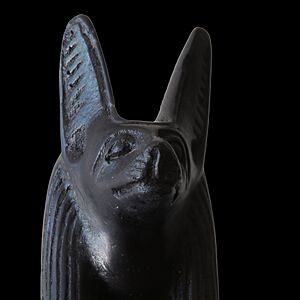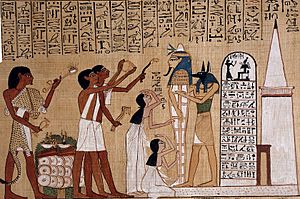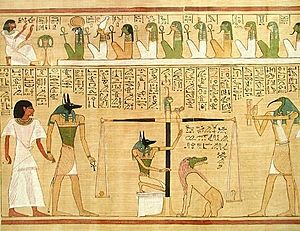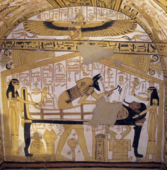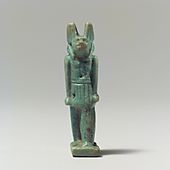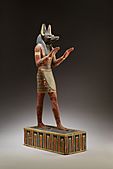Anubis facts for kids
Quick facts for kids Anubis |
|
|---|---|

The Egyptian god Anubis (a modern rendition inspired by New Kingdom tomb paintings)
|
|
| Major cult center | Lycopolis, Cynopolis |
| Symbol | Mummy gauze, jackal, flail |
| Personal information | |
| Consort | Anput, Nephthys |
| Offspring | Kebechet |
| Parents | Nepthys and Set, Osiris (Middle and New kingdom), or Ra (Old kingdom). |
| Siblings | Wepwawet |
| Greek equivalent | Hades or Hermes |
Anubis is an ancient Egyptian god. His name in Ancient Egyptian was Inpu, Inpw, Jnpw, or Anpu. He was known as the god of funerals and a protector of graves. Anubis also guided souls to the underworld, which was the land of the dead.
People usually pictured Anubis as a canine animal. Sometimes he looked like a man with a dog's head. Anubis was also skilled in embalming, which is the process of preserving bodies.
Later, during the Middle Kingdom (around 2055–1650 BC), the god Osiris took over Anubis's role as the lord of the underworld. However, Anubis kept an important job. He was the god who led souls into the afterlife. He was present at the "Weighing of the Heart." This ceremony decided if a soul could enter the land of the dead. Anubis is one of the most famous and often shown gods in Egyptian history.
Anubis was usually shown in black. This color was important to the Egyptians. It stood for new life, the rich soil of the Nile River, and the color a body turned after embalming. Anubis was linked to his brother Wepwawet. Wepwawet was another Egyptian god who looked like a dog, but with grey or white fur. Anubis's female partner was Anput, and his daughter was the snake goddess Kebechet.
Contents
The Name of Anubis
The name "Anubis" is the Greek way of saying this god's Egyptian name. Before the Greeks came to Egypt (around 7th century BC), the god was called Anpu or Inpu. In ancient Egyptian, the root of his name means "a royal child."
The name Inpu is also connected to the word "inp," which means "to decay." Anubis had many other names, showing his different roles:
- "First of the Westerners"
- "Lord of the Sacred Land"
- "He Who is Upon his Sacred Mountain"
- "Ruler of the Nine Bows"
- "The Dog who Swallows Millions"
- "Master of Secrets"
- "He Who is in the Place of Embalming"
- "Foremost of the Divine Booth"
Anubis Through History
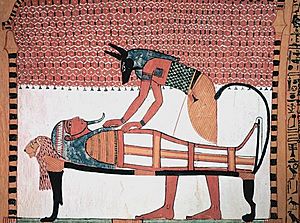
In Egypt's Early Dynastic period (around 3100 – 2686 BC), Anubis was shown as a full animal. He had the head and body of a "jackal."
Before this time, in Predynastic Egypt, people buried the dead in shallow graves. Jackals were often seen near cemeteries because they would eat dead bodies. This is why jackals became strongly linked with the dead.
In the Old Kingdom, Anubis was the most important god of the dead. But during the Middle Kingdom (2000–1700 BC), Osiris took over this role. In the Roman era, which began in 30 BC, tomb paintings show Anubis holding the hand of dead people. He would guide them to Osiris.
In early Egyptian stories, Anubis was sometimes called the son of Ra. Later, around 2181–2055 BC, some stories said he was the son of the cow goddess Hesat or the cat-headed Bastet. Another story said he was the son of Ra and Nephthys. The Greek writer Plutarch (around 40–120 AD) wrote that Anubis was the son of Nephthys and Osiris. However, Osiris's wife Isis adopted him. In Nubia, Anubis was seen as the husband of his mother, Nephthys.
Anubis's Important Jobs
The Embalmer God
Anubis was closely connected to mummification. He was also called ḫnty zḥ-nṯr, meaning "He who presides over the god's booth." This "booth" could be the place where embalming happened. It could also refer to the pharaoh's burial room.
In the Osiris myth, Anubis helped the goddess Isis. He helped her to embalm Osiris. This was after Osiris had been killed by Set. Osiris's body parts were given to Anubis as a gift. Because of this, Anubis became the special god of embalmers. During mummification rituals, pictures from the Book of the Dead often show a priest wearing a wolf mask. This priest would support the upright mummy.
Protector of Tombs
Anubis was a strong protector of graves and cemeteries.
One story, from the Jumilhac papyrus, tells how Anubis protected Osiris's body from Set. Set tried to attack Osiris's body by turning into a leopard. But Anubis stopped Set. He even used a hot iron rod to mark Set's skin. Anubis then wore Set's skin. This was a warning to anyone who might try to harm the tombs of the dead. Priests who cared for the dead wore leopard skin. This was to remember Anubis's win over Set. This story also explained why leopards have spots.
Most ancient tombs had prayers to Anubis carved on them. This showed how important he was for protecting the dead.
Guide of Souls
By the late pharaonic era (664–332 BC), Anubis was often shown guiding people. He would lead them from the world of the living to the afterlife. He helped them cross this important boundary.
Weigher of Hearts
One of Anubis's key jobs was being the "Guardian of the Scales." A very important scene in the Book of the Dead shows this. Anubis performs a measurement that decides a person's fate. He weighs the heart of the dead person against Ma'at. Ma'at was the goddess of truth and justice, often shown as an ostrich feather.
If a soul's heart was heavier than the feather, it meant they had done bad deeds. Such souls would be eaten by Ammit, a monster. But if a soul's heart was lighter than the feather, it meant they were pure. These souls would go on to a heavenly afterlife.
Anubis in Art
Anubis was one of the most commonly shown gods in ancient Egyptian art. He appears in royal tombs as early as the First Dynasty. He is often shown caring for a king's body. He also oversees mummification rituals and funerals. Sometimes he stands with other gods at the Weighing of the Heart of the Soul. This happens in the Hall of Two Truths. A popular image shows him with a man's body and a jackal's head. He stands or kneels, holding a gold scale. On the scale, a heart is weighed against Ma'at's white truth feather.
In the early dynastic period, he was shown as a black canine animal. Anubis's black color was not just about the animal. It had several special meanings. It stood for the body's color change after being treated with natron. It also represented the dark resin used on the mummy wrappings. Black was also the color of the fertile silt from the Nile River. To Egyptians, black meant fertility and the chance of being reborn in the afterlife. In the Middle Kingdom, Anubis was often shown as a man with a jackal's head. A very rare image of him as a fully human figure was found in a chapel of Ramesses II in Abydos.
Anubis is often shown wearing a ribbon. He holds a nḫ3ḫ3 "flail" in his arm. Another item linked to Anubis was the jmy-wt or imiut fetish. This was named for his role in embalming. In burial scenes, Anubis is either helping a dead person's mummy or sitting on top of a tomb, protecting it. New Kingdom tomb-seals also show Anubis sitting on top of the nine bows. These bows stood for his power over Egypt's enemies.
-
Lintel of Amenemhat I and deities; 1981–1952 BC; painted limestone; 36.8 × 172 cm; Metropolitan Museum of Art (New York City)
-
The Anubis Shrine; 1336–1327 BC; painted wood and gold; 1.1 × 2.7 × 0.52 m; from the Valley of the Kings; Egyptian Museum (Cairo)
Worship of Anubis
Anubis was very popular with Egyptians and people from other cultures. The Greeks connected him to their god Hermes. Hermes was the god who guided the dead to the afterlife. This pairing later became known as Hermanubis. Anubis was widely worshipped. This is because he gave people hope. They felt sure their bodies would be respected after death. They also believed their souls would be protected and judged fairly.
Anubis had male priests who wore wooden masks. These masks looked like the god himself. They wore them when performing rituals. His main worship center was at Cynopolis in Upper Egypt. But temples and memorials were built everywhere. He was respected in every part of the nation.
Anubis in Popular Culture
In modern books, video games, and movies, Anubis is often shown incorrectly. He is sometimes seen as a scary or evil god of the dead. He became very popular in the 20th and 21st centuries. Artists would give him evil powers and a dangerous army. But despite this false reputation, his image is still one of the most recognized Egyptian gods. Copies of his statues and paintings are still very popular today.
See also
 In Spanish: Anubis para niños
In Spanish: Anubis para niños


